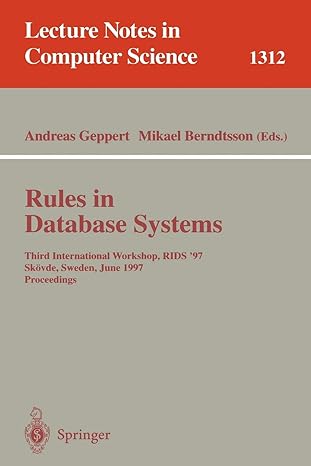Question
Please do Part 2, The mips coding assignment: HW2-2-shell.asm --------------------------------------------------------------------------------------------------------------------------------------------------------------------------------------------------------------------------------------------- # Color Matcher # # Your Name: # # Date: # # This program finds
Please do Part 2, The mips coding assignment:
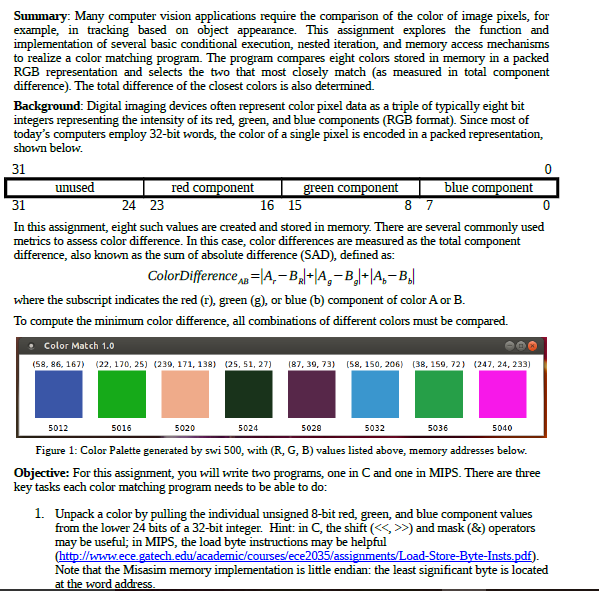
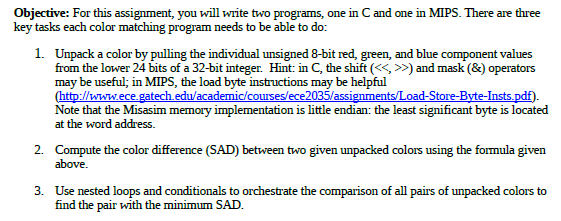
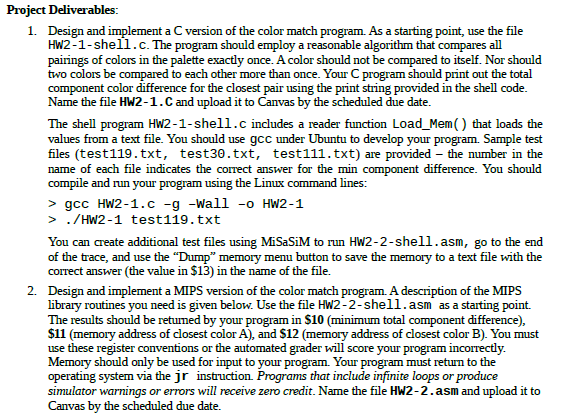
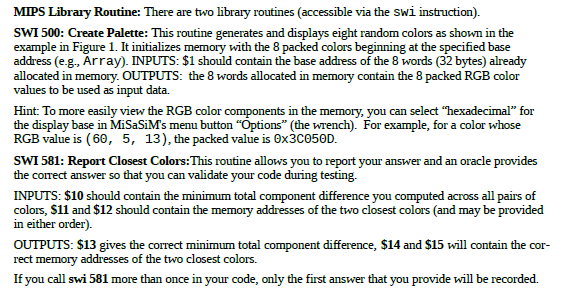
HW2-2-shell.asm
---------------------------------------------------------------------------------------------------------------------------------------------------------------------------------------------------------------------------------------------
# Color Matcher # # Your Name: # # Date: # # This program finds the two closest colors in a eight color palette. # # required output register usage: # $10: minimum total component difference # $11 and $12: memory addresses of the two closest colors
.data Array: .alloc 8 # allocate static space for packed color data
.text ColorMatch: addi $1, $0, Array # set memory base swi 500 # create color palette and update memory
###################################################### # Temporary: the following 3 instructions demo use of swi 581. # Be sure to replace them. addi $10, $0, 48 # guess min component difference addi $11, $1, 12 # guess an address addi $12, $1, 4 # guess an address ######################################################
swi 581 # report answer (in $10, $11, $12) jr $31 # return to caller
---------------------------------------------------------------------------------------------------------------------------------------------------------------------------------------------------------------------------------------------
Objective: For this assignment, you will write two programs, one in C and one in MIPS. There are three key tasks each color matching program needs to be able to do: 1. Unpack a color by pulling the individual unsigned 8-bit red, green, and blue component values from the lower 24 bits of a 32-bit integer. Hint: in C, the shift (>) and mask (&) operators may be useful; in MIPS, the load byte instructions may be helpful (http://www.ece.gatech edu/academic/courses/ece2035/assignments/Load-Store-Byte-Insts.pdf Note that the Misasim memory implementation is little endian: the least significant byte is located at the word address. 2. Compute the color difference (SAD) between two given unpacked colors using the formula given above. 3. Use nested loops and conditionals to orchestrate the comparison of all pairs of unpacked colors to find the pair with the minimum SAD. Project Deliverables 1. Design and implement a C version of the color match program. As a starting point, use the file Hw2-1-shell.c. The program should employ a reasonable algorithm that compares all pairings of colors in the palette exactly once. Acolor should not be compared to itself. Nor should two colors be compared to each other more than once. Your C program should print out the total component color difference for the closest pair using the print string provided in the shell code Name the file HW2-1.C and upload it to Canvas by the scheduled due date. The shell program HW2-1-shell.c includes a reader function Load_Mem() that loads the values from a text file. You should use gcc under Ubuntu to develop your program. Sample test files (test119.txt, test30.txt, test111.txt) are provided - the number in the name of each file indicates the correct answer for the min component difference. You should compile and run your program using the Linux command lines: >gcc HW2-1.c -g -Wall -o HW2-1 /HW2-1 test119.txt You can create additional test files using MiSaSiM to run HW2-2-shell.asm, go to the end of the trace, and use the "Dump" memory menu button to save the memory to a text file with the correct answer (the value in $13) in the name of the file. 2. Design and implement a MIPS version of the color match program. A description of the MIPS library routines you need is given below. Use the file HW2-2-shell.asm as a starting point. The results should be returned by your program in $10 (minimum total component difference), $11 (memory address of closest color A), and $12 (memory address of closest color B). You must use these register conventions or the automated grader will score your program incorrectly Memory should only be used for input to your program. Your program must return to the operating system via the jr instruction Programs that include infinite loops or produce simulator warnings or errors will receive zero credit. Name the file HW2-2.asm and upload it to Canvas by the scheduled due date. MIPS Library Routine: There are two library routines (accessible via the swi instruction). SwI 500: Create Palette: This routine generates and displays eight random colors as shown in the example in Figure 1. It initializes memory with the 8 packed colors beginning at the specified base address (eg, Array). INEUTS: $1 should contain the base address of the 8 words (32 bytes) already allocated in memory. OUTPUTS: the 8 words allocated in memory contain the 8 packed RGB color values to be used as input data. Hint: To more easily view the RGB color components in the memory, you can select "hexadecimal" for the display base in MiSaSiMs menu button "Options" (the wrench). For example, for a color whose RGB value is (60, 5, 13), the packed value is 0x3 c0500 SWI581: Report Closest Colors: This routine allows you to report your answer and an oracle provides the correct answer so that you can validate your code during testing. INPUTS: $10 should contain the minimum total component difference you computed across all pairs of colors, S11 and $12 should contain the memory addresses of the two closest colors (and may be provided in either order). OUTPUTS: $13 gives the correct minimum total component difference, $14 and $15 will contain the cor- rect memory addresses of the two closest colors. If you cll sui 5981 more than once in your code, onmly the first ansiwer that you provide will be recorded. Objective: For this assignment, you will write two programs, one in C and one in MIPS. There are three key tasks each color matching program needs to be able to do: 1. Unpack a color by pulling the individual unsigned 8-bit red, green, and blue component values from the lower 24 bits of a 32-bit integer. Hint: in C, the shift (>) and mask (&) operators may be useful; in MIPS, the load byte instructions may be helpful (http://www.ece.gatech edu/academic/courses/ece2035/assignments/Load-Store-Byte-Insts.pdf Note that the Misasim memory implementation is little endian: the least significant byte is located at the word address. 2. Compute the color difference (SAD) between two given unpacked colors using the formula given above. 3. Use nested loops and conditionals to orchestrate the comparison of all pairs of unpacked colors to find the pair with the minimum SAD. Project Deliverables 1. Design and implement a C version of the color match program. As a starting point, use the file Hw2-1-shell.c. The program should employ a reasonable algorithm that compares all pairings of colors in the palette exactly once. Acolor should not be compared to itself. Nor should two colors be compared to each other more than once. Your C program should print out the total component color difference for the closest pair using the print string provided in the shell code Name the file HW2-1.C and upload it to Canvas by the scheduled due date. The shell program HW2-1-shell.c includes a reader function Load_Mem() that loads the values from a text file. You should use gcc under Ubuntu to develop your program. Sample test files (test119.txt, test30.txt, test111.txt) are provided - the number in the name of each file indicates the correct answer for the min component difference. You should compile and run your program using the Linux command lines: >gcc HW2-1.c -g -Wall -o HW2-1 /HW2-1 test119.txt You can create additional test files using MiSaSiM to run HW2-2-shell.asm, go to the end of the trace, and use the "Dump" memory menu button to save the memory to a text file with the correct answer (the value in $13) in the name of the file. 2. Design and implement a MIPS version of the color match program. A description of the MIPS library routines you need is given below. Use the file HW2-2-shell.asm as a starting point. The results should be returned by your program in $10 (minimum total component difference), $11 (memory address of closest color A), and $12 (memory address of closest color B). You must use these register conventions or the automated grader will score your program incorrectly Memory should only be used for input to your program. Your program must return to the operating system via the jr instruction Programs that include infinite loops or produce simulator warnings or errors will receive zero credit. Name the file HW2-2.asm and upload it to Canvas by the scheduled due date. MIPS Library Routine: There are two library routines (accessible via the swi instruction). SwI 500: Create Palette: This routine generates and displays eight random colors as shown in the example in Figure 1. It initializes memory with the 8 packed colors beginning at the specified base address (eg, Array). INEUTS: $1 should contain the base address of the 8 words (32 bytes) already allocated in memory. OUTPUTS: the 8 words allocated in memory contain the 8 packed RGB color values to be used as input data. Hint: To more easily view the RGB color components in the memory, you can select "hexadecimal" for the display base in MiSaSiMs menu button "Options" (the wrench). For example, for a color whose RGB value is (60, 5, 13), the packed value is 0x3 c0500 SWI581: Report Closest Colors: This routine allows you to report your answer and an oracle provides the correct answer so that you can validate your code during testing. INPUTS: $10 should contain the minimum total component difference you computed across all pairs of colors, S11 and $12 should contain the memory addresses of the two closest colors (and may be provided in either order). OUTPUTS: $13 gives the correct minimum total component difference, $14 and $15 will contain the cor- rect memory addresses of the two closest colors. If you cll sui 5981 more than once in your code, onmly the first ansiwer that you provide will be recordedStep by Step Solution
There are 3 Steps involved in it
Step: 1

Get Instant Access to Expert-Tailored Solutions
See step-by-step solutions with expert insights and AI powered tools for academic success
Step: 2

Step: 3

Ace Your Homework with AI
Get the answers you need in no time with our AI-driven, step-by-step assistance
Get Started


